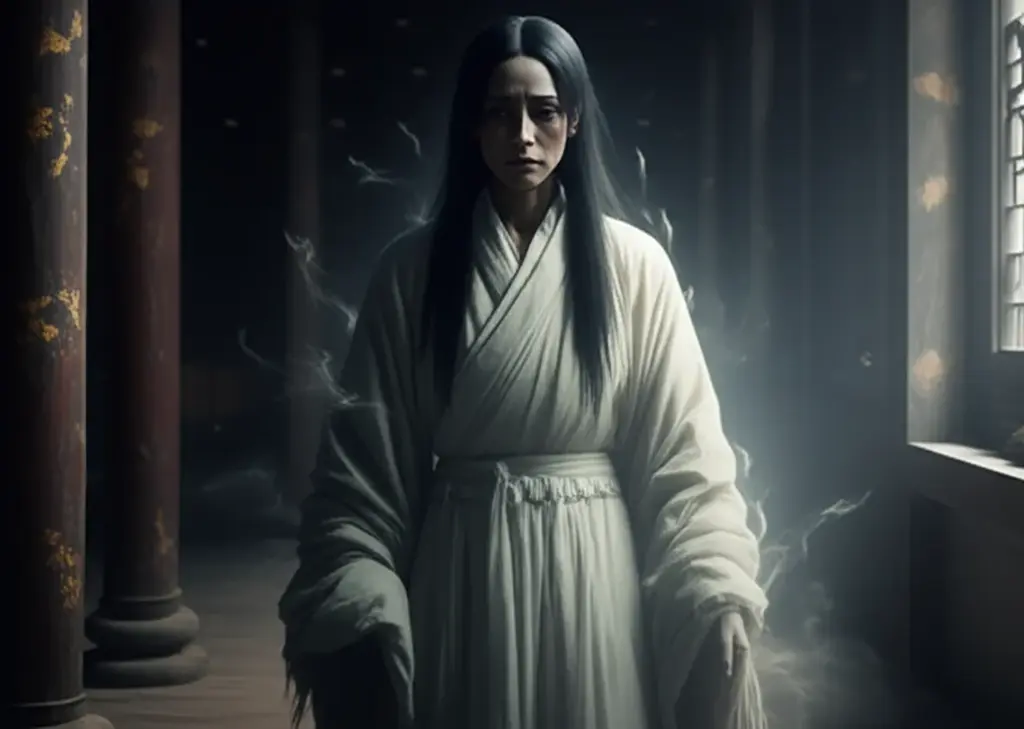Mourning Attire Ghost, also known as 孝服鬼 (Xiàofú Guǐ) or the Funeral Robe Spirit, is a vengeful entity rooted in Chinese spiritual folklore. This ghost appears in white ceremonial mourning clothes, symbolizing death and unresolved grief. According to traditional beliefs, the Xiàofú Guǐ manifests when funeral rites are disrespected, or when the spirit of the deceased is dishonored.

Information
- Name: Mourning Attire Ghost / 孝服鬼 / Xiàofú Guǐ
- Gender: Can manifest as either male or female
- Age: Over 1,400 years since the Tang Dynasty (around 650 CE)
- Abilities: Haunting dreams, appearing in mirrors, causing sudden illness, inducing guilt-induced madness
- Interests: Punishing disrespect toward the dead, maintaining spiritual order
- Cultural Presence: Referenced in folk tales, ghost operas, and ancestor worship rituals
Origin
Ghosts wearing mourning clothes originate from the ancient funeral traditions of China, especially during the Han and Tang dynasties, when funeral attire was considered essential to honor the deceased. According to historical records in the ancient Chinese texts Shǐjì (Records of the Grand Historian) by Sima Qian and Jiù Táng Shū (Old Book of Tang), if families neglected proper burial rituals, the souls of the deceased could become trapped, unable to pass on to the afterlife.
One of the earliest references to Xiàofú Guǐ appears in the Yuan Gui Ji (Records of Ghost Origins), a Song Dynasty manuscript, which describes a woman whose son refused to wear mourning clothes after her death. Her unresolved sorrow transformed her into a vengeful spirit, haunting the family home in white funeral robes.
Another tale from Zhejiang Province tells of a wealthy merchant who mocked a poor man’s simple funeral ceremony. Soon after, he began seeing a pale figure in white robes, whispering accusations at night. His health deteriorated rapidly until he performed proper rites for all forgotten ancestors, appeasing the spirit.
Characteristics
The Mourning Attire Ghost is typically depicted as a tall, pale figure draped in flowing white robes, resembling traditional Chinese funeral attire. Its face may appear serene or twisted in sorrow, depending on its emotional state. Some folklorists believe that the length and condition of the robe reflect the level of respect shown to the deceased.
This ghost does not attack physically but instead haunts emotionally, using guilt, fear, and remorse to torment those who have disrespected the dead. It may appear in dreams, mirrors, or shadows, often accompanied by the sound of weeping. In certain regions, such as Fujian and Jiangxi, it is believed that the Xiàofú Guǐ can only be seen by those who have broken ancestral taboos. In extreme cases, victims may experience sleep paralysis, nightmares, or even mental breakdowns.
Cultural Significance
The Mourning Attire Ghost serves as a moral guardian of ancestral customs. Its presence reinforces the importance of proper funeral rites, respect for elders, and maintaining harmony between the living and the dead.
In traditional Chinese opera, especially ghost plays and shadow puppet theater, the Xiàofú Guǐ often appears to warn characters about the consequences of neglecting ancestors. One notable example is the Qing-era opera The Curse of Neglect, where a nobleman is haunted by a white-robed specter after ignoring his father’s final wishes.
Even today, in rural areas of Guangdong, Sichuan, and Hunan, families still follow strict mourning customs to avoid attracting the Mourning Attire Ghost. Elders warn children not to mock funerals or disturb ancestral rituals, emphasizing the belief that Xiàofú Guǐ watches over the integrity of tradition.
The Mourning Attire Ghost remains one of the most culturally resonant figures in Chinese supernatural folklore. As both a symbol of vengeance and a guardian of tradition, it reflects the enduring power of ancestral respect and the deep-rooted belief in spirits of the dead. Whether through folk tales, rituals, or modern media, the Funeral Robe Spirit continues to influence how many view death, duty, and divine justice in Chinese society.
